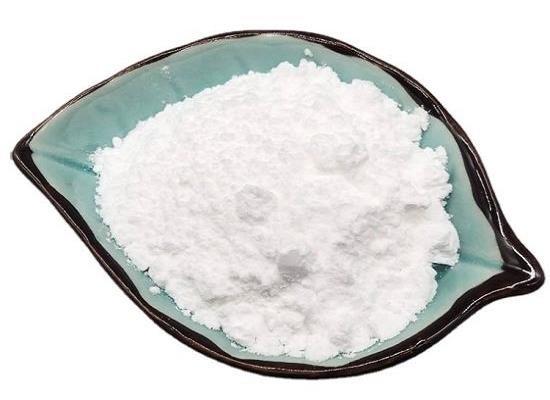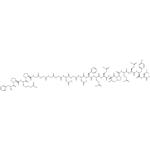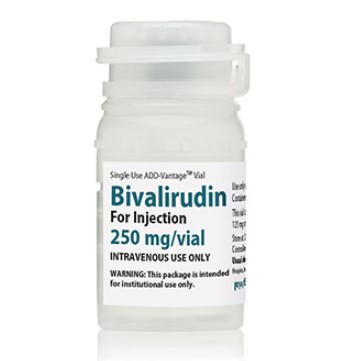Bivalirudin: Overview, Pharmacology and Clinical Applications
General Description
Bivalirudin is direct thrombin inhibitor with unique pharmacological properties, which is widely used in invasive cardiology for its efficacy in preventing blood clot formation during procedures. Derived from hirudin, it binds transiently to thrombin, offering control over anticoagulation therapy duration. Its reversible binding mechanism and rapid clearance reduce bleeding risks.
Clinically, bivalirudin is crucial in percutaneous coronary interventions, especially for patients with or at risk of heparin-induced thrombocytopenia. It also shows promise in acute coronary syndrome and myocardial infarction management, cardiac surgery, and treating acute HIT. Overall, bivalirudin presents a valuable alternative to heparin in various cardiovascular settings.

Figure 1. Bivalirudin
Overview
Bivalirudin is a direct thrombin inhibitor which is commonly employed as an anticoagulant in invasive cardiology procedures. Unlike other available direct thrombin inhibitors like lepirudin, argatroban, and desirudin, bivalirudin has specific uses such as treating heparin-induced thrombocytopenia or post-orthopedic surgery thromboprophylaxis, bivalirudin has found widespread use in mainstream invasive cardiology.
As a direct thrombin inhibitor, it directly inhibits the activity of thrombin, an enzyme crucial for blood clot formation. By blocking thrombin, bivalirudin helps prevent the formation of harmful blood clots during invasive cardiology procedures, reducing the risk of complications such as myocardial infarction or stroke.
Bivalirudin's popularity in invasive cardiology stems from its favorable pharmacologica profile and clinical efficacy. It has a relatively short half-life, allowing for rapid clearance from the body, which provides clinicians with greater control over the duration of anticoagulation therapy. Additionally, bivalirudin has a reversible binding mechanism with thrombin, making it easier to manage potential bleeding complications compared to other anticoagulants. 1
Clinical applications
Heparin is the universal anticoagulant for patients receiving extracorporeal membrane oxygenation support. However, heparin has many disadvantages, especially in young children, who develop heparin resistance. Recently our center has used bivalirudin, a direct thrombin inhibitor, for systemic anticoagulation in pediatric extracorporeal life support. Bivalirudin binds directly to thrombin with no need for antithrombin III and it inhibits both circulating and clotbound thrombin. In this study, we sought to evaluate our experience with bivalirudin in pediatric extracorporeal life support.
Sixteen patients receiving heparin and 16 patients receiving bivalirudin on extracorporeal life support were included in the study.
Patients in the bivalirudin group had a median age of 31 months versus 59 months in the heparin group (p = 0.41). Recovery and extracorporeal membrane oxygenation decannulation were similar in both groups (56% in the heparin group and 62% in the bivalirudin group; p = 0.62).
Time to reach goal therapeutic anticoagulation level was shorter in the bivalirudin group (11 vs 29hr; p = 0.01). Bleeding events were fewer in the bivalirudin group, and there was no difference in the rate of thrombotic events between the two groups. Comprehensive cost analysis that includes anticoagulant, laboratories, and antithrombin III cost, showed that heparin anticoagulation therapy total cost was significantly higher than bivalirudin (1,184 dollars per day in heparin group vs 494 dollars per day in bivalirudin group; p = 0.03). Bivalirudin dose required to maintain target anticoagulation will increase over time, and this is associated with an increase in creatinine clearance and an increase in fibrinogen serum levels.
This study showed that the use of bivalirudin in pediatric extracorporeal membrane oxygenation support is feasible, safe, reliable, and cost-effective in comparison to heparin.2
Heparin for Systemic Anticoagulation in Pediatric Extracorporeal Membrane Oxygenation. doi:10.1097/PCC.0000000000002384References:
[1] L. RYERSON A M. Bivalirudin in pediatric extracorporeal membrane oxygenation[J]. Current opinion in pediatrics, 2022, 34 1: 255-260. DOI:10.1097/MOP.0000000000001131.[2] MOHAMMED HAMZAH. Evaluation of Bivalirudin As an Alternative to Heparin for Systemic Anticoagulation in Pediatric Extracorporeal Membrane Oxygenation.[J]. Pediatric Critical Care Medicine, 2020, 21 9. DOI:10.1097/PCC.0000000000002384.
Related articles And Qustion
Lastest Price from Bivalirudin manufacturers

US $1000.00-1000.00/g2025-09-16
- CAS:
- 128270-60-0
- Min. Order:
- 1g
- Purity:
- 99%(HPLC); USP43
- Supply Ability:
- 10000000

US $0.00-0.00/kg2025-09-04
- CAS:
- 128270-60-0
- Min. Order:
- 1kg
- Purity:
- 99%
- Supply Ability:
- 1



